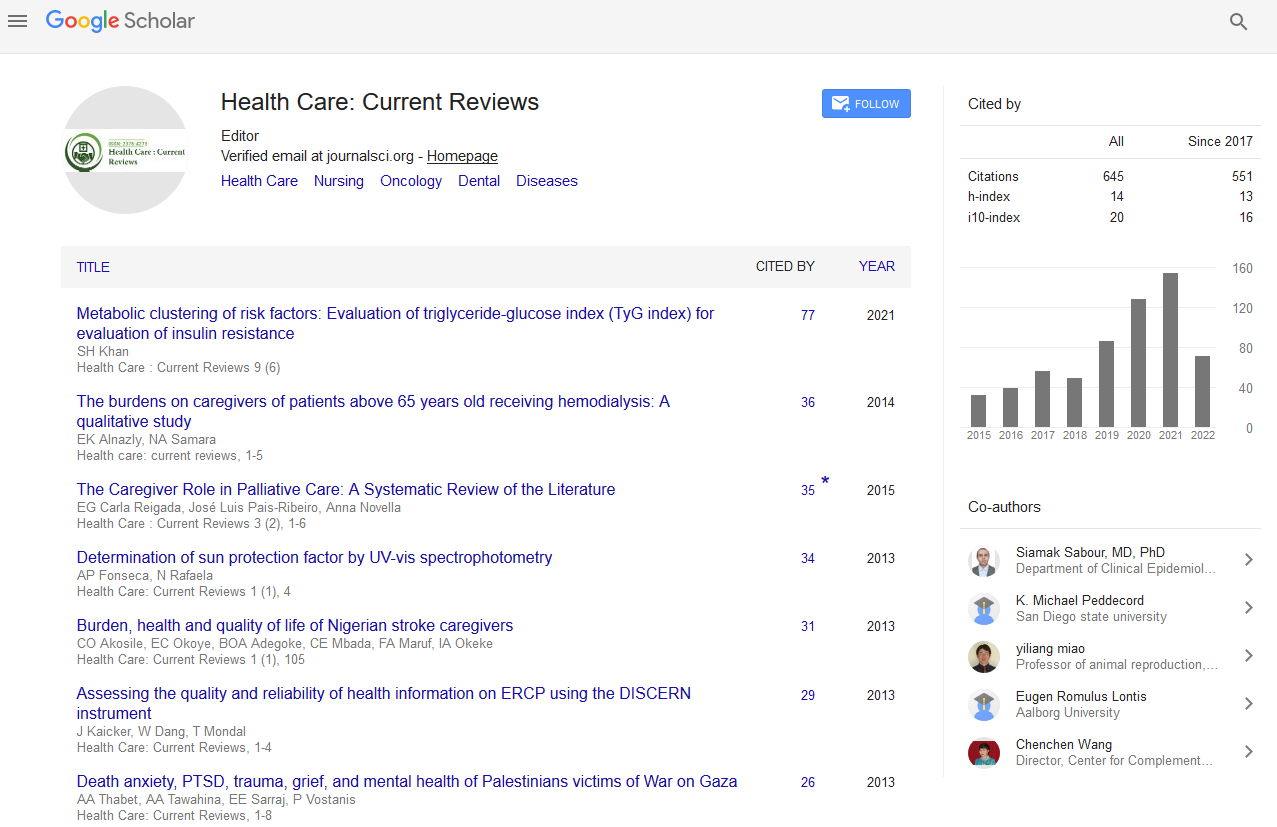PMC/PubMed Indexed Articles
Indexed In
- Open J Gate
- Academic Keys
- RefSeek
- Hamdard University
- EBSCO A-Z
- Publons
- Geneva Foundation for Medical Education and Research
- Google Scholar
Useful Links
Share This Page
Journal Flyer

Open Access Journals
- Agri and Aquaculture
- Biochemistry
- Bioinformatics & Systems Biology
- Business & Management
- Chemistry
- Clinical Sciences
- Engineering
- Food & Nutrition
- General Science
- Genetics & Molecular Biology
- Immunology & Microbiology
- Medical Sciences
- Neuroscience & Psychology
- Nursing & Health Care
- Pharmaceutical Sciences
Abstract
Death Anxiety, PTSD, Trauma, Grief, And Mental Health Of Palestinians Victims Of War On Gaza
Thabet AA, Tawahina AA, Sarraj EE and Vostanis P
Purpose: Exposure to war trauma has been independently associated with posttraumatic stress (PTSD) and grief in children and adults. The aim of this study was to establish the relationship between war traumatic experiences due to last war on Gaza, PTSD, traumatic grief, death anxiety, and general mental health. 1.2. Methods: The study was conducted in the Gaza Strip; in areas exposed to war for 23 days. The sample included 374 adults aged from 22 to 65 years with mean age 40.13. Participants completed measures of experience of traumatic events (Gaza Traumatic Checklist-War on Gaza), PTSD, Grief inventory, Arabic Version of Death Anxiety Scale, and GHQ-28. 1.3. Results: Palestinians experiences variety of traumatic events: The most common reported traumatic events were: 95.7% said they hear of shelling and bombardment of the their area, 94.7% reported watching mutilated bodies in TV, 92.8 % reported seeing the bombardment effects on ground, 71.7% said they had lack of water, food and electricity during the war, and 72.2% said they moved to save place during the war. Each person reported 13.80 traumatic events. The results showed that no one felt safe at home, 2.1% of fathers said they were able to protect their children, while 2.8% of mothers said they were safe at homes. The study showed that 3.1% fathers were able to protect their children compared to 6.6% of mothers, 2.8% of fathers were able to protect themselves compared to 6.1% of mothers, and 3.1% of fathers said that someone outside the home were able to protect him compared to 2.8% of mothers. The study showed that 71 persons lost someone from their family included extended family which represented 18.8 % of the participants and 303 did not loss anyone (81.2%) from their families (first, second, third relatives) during the war compared. The study showed that mean grief reaction was 11.52 (SD = 4.82). The study showed that mean grief reactions reported by male were 10.1 and mean in female was 12.69. There were statistically significant differences toward females in grief reactions. Using scoring of DSM-IV of one intrusion symptom, three avoidance, and two arousal symptoms, 248 people rated as PTSD which represented 66.6 % of the sample and 125 persons reported no PTSD (35.5%). The results showed that PTSD was reported more in females compared to males. The results showed that mean death anxiety in males was 37.4 compared to female mean = 44.9. There were statistically significant differences toward females. The study showed than mean GHQ-28 was 15.6, somatization mean was 4.3, anxiety mean was 5, social dysfunction mean was 3.2, and depression mean was 3.2. Using the previous cutoff point of the GHQ-28 (4/5), the result showed that 90.9% were rated as cases and need further investigation, while 9.1% were not cases. 1.4. Conclusions: This study revealed each person reported 13.80 traumatic events. The results showed that no one felt safe at home. The study showed that 71 persons lost someone from their family included extended family which resulted in grief reaction where females reported more grief reactions. PTSD rate was 66.6 % of the sample PTSD was reported more in females compared to males. Those victims had to be evaluated and treated as soon as the war finished and not leaving them to develop pathological grief and other mental health problems such as depression. Training programs must be created for people living in area of war and conflict including community sessions to increase their awareness about the impact of war on their psychosocial health and ways of coping with such problems in similar situation. Also, new intervention programs must be established for bereaved people using individual psychotherapy, psychoeducation, group crisis intervention, and community based intervention. International organizations and national organization must work during war to protect civilian people from the atrocities of the war and provided a safe place for people and their children.


